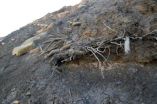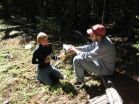(Press-News.org) University of Guelph researchers have finally figured out why female squirrels are so darn promiscuous. Turns out it has nothing to do with genes and everything to do with how many males are knocking at their door.
"Their behaviour is overwhelmingly influenced by opportunity," said graduate student Eryn McFarlane, who, along with integrative biology professor Andrew McAdam and a team of researchers from across Canada, solved a mystery that has baffled biologists for years.
Their findings appear in the Royal Society Journal Biology Letters.
Female squirrels are less than picky when it comes to mating, often entertaining as many suitors as possible. Such risky female behaviour is puzzling in the mammal world.
Although it makes sense for male squirrels to have as many mates as possible to ensure the most offspring, promiscuity doesn't always make sense for females, said McFarlane.
"Having multiple partners means more energy expended on mating, increased exposure to predators as well as increased potential for the spread of sexually transmitted diseases," she said. "Promiscuity also encourages harassment from male squirrels trying to coerce them into having sex."
Trying to solve this puzzle has prompted a lot of research into the possible benefits of mating with many males, said McAdam. However, optimal mating strategies can evolve only if there is a genetic basis to the behaviour.
The Guelph team discovered that female squirrel behaviour results from opportunity alone and not from genetics, limiting its ability to evolve.
"We found the more males in the area interested in participating in the mating chase, the more squirrels she will mate with," McFarlane said. "There are no strong ties between mating behaviour and genetics in red squirrels. So even if the costs of mating with many males outweighs the benefits there doesn't seem to be much capacity for them to evolve lower levels of promiscuity."
The researchers analyzed data collected from 108 mating chases involving 85 female squirrels. Researchers Jeff Lane and Ryan Taylor collected the data as part of the Kluane Red Squirrel Project, a long-term field experiment in the Yukon investigating the importance of food abundance to the ecology and evolution of red squirrels. Established in 1987, the project has seen scientists from several collaborating universities, including the University of Guelph, monitoring behaviour and reproduction of about 7,000 squirrels.
After analyzing the data, McFarlane and McAdam found that female squirrels mated with anywhere from one to 14 partners and that female promiscuity was not reliably inherited by offspring.
"A female squirrel that only chose to mate with one male could have a daughter that mates with many males," McAdam said. "It seems the tendency to mate with fewer males isn't something that is being passed down to offspring."
A female red squirrel usually goes into heat for only a single day each year, typically releasing three or four eggs to be fertilized. During the preceding few days, she leaves scent nearby to let males know she's getting ready. On the day itself, she runs around to encourage interested males to give chase.
Whether several males, or perhaps only one or two, wait by the nest, females often mate with as many as are available.
"The reality is that organisms cannot always be well adapted to their environment," said McAdam. "Sometimes organisms do things that detract from their survival because they aren't able to evolve a better alternative."
INFORMATION:
For more information and photos of the research study visit http://www.redsquirrel.ca/KRSP/Media.html
For media questions, contact Communications and Public Affairs: Lori Bona Hunt, 519-824-4120, Ext. 53338, or lhunt@uoguelph.ca, or Deirdre Healey, Ext. 56982 or dhealey@uoguelph.ca.
Contacts:
Eryn McFarlane
lead researcher, integrative biology graduate student
519-835-3039
mcfarlas@uoguelph.ca
Prof. Andrew McAdam
Department of Integrative Biology
519-824-4120, Ext.56826
amcadam@uoguelph.ca
Opportunity leads to promiscuity among squirrels, study finds
2010-12-16
ELSE PRESS RELEASES FROM THIS DATE:
'Green genes' in yeast may boost biofuel production by increasing stress tolerance
2010-12-16
An effort to increase biofuel production has led scientists to discover genes in yeast that improve their tolerance to ethanol, allowing them to produce more ethanol from the same amount of nutrients. This study, published in the December 2010 issue of Genetics (http://www.genetics.org), shows how genetically altered yeast cells survive higher ethanol concentrations, addressing a bottleneck in the production of ethanol from cellulosic material (nonfood plant sources) in quantities that could make it economically competitive with fossil fuels.
"Our hope is that this ...
Ancient forest emerges mummified from the Arctic
2010-12-16
SAN FRANCISCO -- The northernmost mummified forest ever found in Canada is revealing how plants struggled to endure a long-ago global cooling.
Researchers believe the trees -- buried by a landslide and exquisitely preserved 2 to 8 million years ago -- will help them predict how today's Arctic will respond to global warming.
They also suspect that many more mummified forests could emerge across North America as Arctic ice continues to melt. As the wood is exposed and begins to rot, it could release significant amounts of methane and carbon dioxide into the atmosphere ...
New colonoscopy skills assessment tool developed for trainees
2010-12-16
OAK BROOK, Ill. – Dec. 15, 2010 – Researchers at the Mayo Clinic in Rochester, Minn., have developed a new skills assessment tool for colonoscopy trainees. A report outlining the development and validation of the Mayo Colonoscopy Skills Assessment Tool (MCSAT), designed for the assessment of cognitive and motor skills during colonoscopy training, appears in the December issue of GIE: Gastrointestinal Endoscopy, the monthly peer-reviewed scientific journal of the American Society for Gastrointestinal Endoscopy (ASGE).
Ensuring that gastroenterology fellows and surgery ...
Missing molecules hold promise of therapy for pancreatic cancer
2010-12-16
By determining what goes missing in human cells when the gene that is most commonly mutated in pancreatic cancer gets turned on, Johns Hopkins scientists have discovered a potential strategy for therapy.
The production of a particular cluster of genetic snippets known as microRNAs is dramatically reduced in human pancreatic tumor cells compared to healthy tissue, the researchers report in a study published Dec. 15 in Genes and Development. When the team restored this tiny regulator, called miR-143/145, back to normal levels in human pancreatic cancer cells, those cells ...
Nanoscale gene 'ignition switch' may help spot and treat cancer
2010-12-16
In a proof of principal study in mice, scientists at Johns Hopkins and the Virginia Commonwealth University (VCU) have shown that a set of genetic instructions encased in a nanoparticle can be used as an "ignition switch" to rev up gene activity that aids cancer detection and treatment.
The switch, called a promoter, is a set of chemical letters that interacts with DNA to turn on gene activity. In this case, the scientists used a promoter called PEG-Prom, cloned by VCU researcher Paul Fisher, Ph.D. PEG-Prom is activated only when inside cancer cells, not in normal ones.
"With ...
UGA researchers develop rapid diagnostic test for common type of pneumonia
2010-12-16
Athens, Ga. – University of Georgia researchers have developed a technique that can diagnose a common type of pneumonia within minutes, potentially replacing existing tests that can take several days for results.
The researchers, whose findings are detailed online in the journal PLoS ONE, detected Mycoplasma pneumoniae, which causes atypical or "walking pneumonia," in true clinical samples with over 97 percent accuracy using a recently-developed nanotechnology-based platform.
"If you can make a positive identification from a 10-minute test, then appropriate antibiotics ...
A positive mood allows your brain to think more creatively
2010-12-16
People who watch funny videos on the internet at work aren't necessarily wasting time. They may be taking advantage of the latest psychological science—putting themselves in a good mood so they can think more creatively.
"Generally, positive mood has been found to enhance creative problem solving and flexible yet careful thinking," says Ruby Nadler, a graduate student at the University of Western Ontario. She and colleagues Rahel Rabi and John Paul Minda carried out a new study published in Psychological Science, a journal of the Association for Psychological Science. ...
Protein disables p53, drives breast cells toward cancer transition
2010-12-16
HOUSTON - The recently identified TRIM24 protein plays an active role in pushing normal breast cells into rapid cell proliferation and, potentially, into breast cancer.
Reporting in the journal Nature, a team led by researchers at The University of Texas MD Anderson Cancer Center found that TRIM24 (tripartite motif-containing 24) pushes estrogen-responsive genes toward active expression. This expression, in turn, sets the stage for malignant transformation of breast cells. TRIM24 functions by reading a specific code, or signature, present at estrogen-regulated genes and ...
Elevated zinc concentrations in Colorado waterway likely a result of climate change
2010-12-16
Rising concentrations of zinc in a waterway on Colorado's Western Slope may be the result of climate change that is affecting the timing of annual snowmelt, says a new study led by the University of Colorado at Boulder.
The study focused on the Snake River watershed just west of the Continental Divide near Keystone, Colo., where CU-Boulder researchers have observed a four-fold increase in dissolved zinc over the last 30 years during the lowest water flow months, said Caitlin Crouch. Crouch, a master's degree student who led the study, said the high levels of zinc affect ...
Study improves understanding of method for creating multi-metal nanoparticles
2010-12-16
A new study from researchers at North Carolina State University sheds light on how a technique that is commonly used for making single-metal nanoparticles can be extended to create nanoparticles consisting of two metals – and that have tunable properties. The study also provides insight into the optical properties of some of these nanoparticles.
Tuning the optical properties of nanoparticles is of interest for applications such as security technology, and for use in making chemical reactions more efficient – which has multiple industrial and environmental applications. ...



